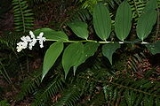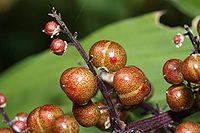
Maianthemum racemosum
Encyclopedia
Maianthemum racemosum is a species of flowering plant
, native to North America
.
It is a woodland herbaceous
perennial plant
growing to 50–90 cm tall, with alternate, oblong-lanceolate leaves
7–15 cm long and 3–6 cm broad. The flower
s are produced on a 10–15 cm panicle, each flower with six white tepal
s 3–6 mm long blooming in late spring. The plants produce green fruits that are round and turn red in late summer.
It grows from cylindrical rhizome
s about 0.3 m long.
, Trillium ovatum
and Adiantum jordanii
.
 The young shoots, while still tender and stripped of their leaves, can be simmered in water and eaten. Their delicate flavor is somewhat reminiscent of asparagus. However, they should not be collected for this purpose unless they are obviously abundant.
The young shoots, while still tender and stripped of their leaves, can be simmered in water and eaten. Their delicate flavor is somewhat reminiscent of asparagus. However, they should not be collected for this purpose unless they are obviously abundant.
Although the young shoots are edible, the plant becomes too fibrous and bitter to enjoy after it completes flowering and seed setting stages. The Ojibwa
Indians harvested the roots of this plant and cooked them in lye water overnight to remove the bitterness and neutralize their strong laxative qualities.
This plant should be consumed in moderation, as it can act as a strong laxative in sensitive individuals. A poultice made from the roots of this plant was used as an effective treatment for sunburns by American Indians. The roots of this plant were often dried and then smoked by several Eastern Native American
tribes as a treatment for hyperactivity in children and emotional depression. The plant was also used by Native Americans as a cough
suppressant.
When young, Maianthemum racemosum may closely resemble members of the genus Veratrum
, a highly toxic plant to which it is distantly related. Consequently, this plant should not be consumed unless identification is positive.
Flowering plant
The flowering plants , also known as Angiospermae or Magnoliophyta, are the most diverse group of land plants. Angiosperms are seed-producing plants like the gymnosperms and can be distinguished from the gymnosperms by a series of synapomorphies...
, native to North America
North America
North America is a continent wholly within the Northern Hemisphere and almost wholly within the Western Hemisphere. It is also considered a northern subcontinent of the Americas...
.
It is a woodland herbaceous
Herbaceous
A herbaceous plant is a plant that has leaves and stems that die down at the end of the growing season to the soil level. They have no persistent woody stem above ground...
perennial plant
Perennial plant
A perennial plant or simply perennial is a plant that lives for more than two years. The term is often used to differentiate a plant from shorter lived annuals and biennials. The term is sometimes misused by commercial gardeners or horticulturalists to describe only herbaceous perennials...
growing to 50–90 cm tall, with alternate, oblong-lanceolate leaves
Leaf
A leaf is an organ of a vascular plant, as defined in botanical terms, and in particular in plant morphology. Foliage is a mass noun that refers to leaves as a feature of plants....
7–15 cm long and 3–6 cm broad. The flower
Flower
A flower, sometimes known as a bloom or blossom, is the reproductive structure found in flowering plants . The biological function of a flower is to effect reproduction, usually by providing a mechanism for the union of sperm with eggs...
s are produced on a 10–15 cm panicle, each flower with six white tepal
Tepal
Tepals are elements of the perianth, or outer part of a flower, which include the petals or sepals. The term tepal is more often applied specifically when all segments of the perianth are of similar shape and color, or undifferentiated, which is called perigone...
s 3–6 mm long blooming in late spring. The plants produce green fruits that are round and turn red in late summer.
It grows from cylindrical rhizome
Rhizome
In botany and dendrology, a rhizome is a characteristically horizontal stem of a plant that is usually found underground, often sending out roots and shoots from its nodes...
s about 0.3 m long.
Distribution
Maianthemum racemosum grows in bicoastal habitats in North America up to elevations of 7,000 feet. The most robust and profuse occurrences of this plant are typically found in partial shade and deep, moist, soft soils. In the western part of North America an example typical habitat would be in a shaded ravine or riparian corridor with common understory associates of Dryopteris argutaDryopteris arguta
Dryopteris arguta, with the common name coastal woodfern, is a species of wood fern. It is native to the west coast of North America, where it grows in oak woodlands and shady low elevation slopes in Southern California and north.-Description:...
, Trillium ovatum
Trillium ovatum
Trillium ovatum, the Western Wake Robin, Pacific Trillium, or Western White Trillium, is a member of the Trilliaceae family, or sometimes included within the Liliaceae or Melanthiaceae. It occurs in parts of the western United States and western Canada, usually in rich forest...
and Adiantum jordanii
Adiantum jordanii
Adiantum jordanii is a perennial species of maidenhair fern known by the common name California maidenhair.It is native to California and Baja California. A...
.
Uses and Identification

Although the young shoots are edible, the plant becomes too fibrous and bitter to enjoy after it completes flowering and seed setting stages. The Ojibwa
Ojibwa
The Ojibwe or Chippewa are among the largest groups of Native Americans–First Nations north of Mexico. They are divided between Canada and the United States. In Canada, they are the third-largest population among First Nations, surpassed only by Cree and Inuit...
Indians harvested the roots of this plant and cooked them in lye water overnight to remove the bitterness and neutralize their strong laxative qualities.
This plant should be consumed in moderation, as it can act as a strong laxative in sensitive individuals. A poultice made from the roots of this plant was used as an effective treatment for sunburns by American Indians. The roots of this plant were often dried and then smoked by several Eastern Native American
Indigenous peoples of the Americas
The indigenous peoples of the Americas are the pre-Columbian inhabitants of North and South America, their descendants and other ethnic groups who are identified with those peoples. Indigenous peoples are known in Canada as Aboriginal peoples, and in the United States as Native Americans...
tribes as a treatment for hyperactivity in children and emotional depression. The plant was also used by Native Americans as a cough
Cough
A cough is a sudden and often repetitively occurring reflex which helps to clear the large breathing passages from secretions, irritants, foreign particles and microbes...
suppressant.
When young, Maianthemum racemosum may closely resemble members of the genus Veratrum
Veratrum
Veratrum is a genus of coarse, highly poisonous perennial herbs of the Melanthiaceae family. In English they are known as the False hellebores or corn lilies. Members of Veratrum are known both in western herbalism and traditional Chinese medicine as toxic herbs to be used with great caution...
, a highly toxic plant to which it is distantly related. Consequently, this plant should not be consumed unless identification is positive.
See also
- M. stellatumMaianthemum stellatumMaianthemum stellatum is a species of flowering plant, native across North America generally from Alaska to California in the west and from Newfoundland to the central Appalachian Mountains in the east...
, also known as False Solomon's Seal - Polygonatum biflorumPolygonatum biflorumPolygonatum biflorum is a species of the family Polygonatum native to eastern North America.-External links:*...
, Solomon's seal - Polygonatum commutatumPolygonatum commutatumPolygonatum commutatum, Solomon's seal or Smooth Solomon's seal, is a widespread native plant of North America, located mainly from the eastern seaboard through the Great Plains. It is usually located in semi-shaded locations....
, Solomon's seal

